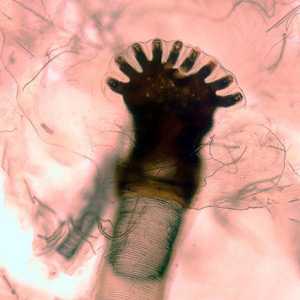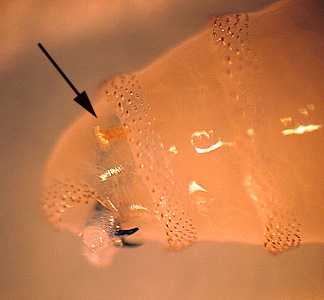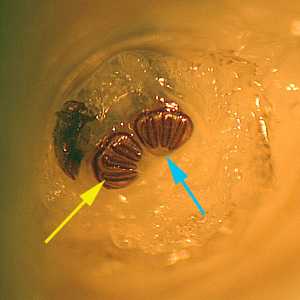
Case #231 - July, 2008
A 25-year-old man, who recently returned from a trip to Brazil, presented to his health care provider with a festering lesion on his forehead. The patient also complained of feeling things moving under his skin. Surgical removal of the outer surface of the lesion revealed several maggot-like organisms (Figure A) beneath the skin. Specimens were sent to the CDC for diagnostic assistance. Figure B shows a close-up of the anterior end of one of the organisms; Figure C shows a close-up of the posterior end. Figures D and E show structures dissected out of the anterior end of one of the organisms. What is your diagnosis? Based on what criteria?

Figure A

Figure B

Figure C

Figure D

Figure E
Case Answer
This was a case of myiasis caused by the New World screwworm fly, Cochliomyia hominovorax. Diagnostic features were:
- cuticular spines on every body segment (Figure A).
- a fan-shaped anterior spiracle (arrow, Figure B and Figure E) with greater than seven lobes.
- posterior spiracles with three spiracular slits (yellow arrow, Figure C) and a weak ecdysial scar (blue arrow, Figure C).
- a cephalopharyngeal skeleton consistent with the species (Figure D).

Figure B

Figure C
Cochliomyia hominovorax is the primary screwworm fly in the New World. Larvae are obligate parasites of living flesh in humans and other mammals. Human cases are not common but may be seen in regions where livestock is tended. Females oviposit on or near pre-existing wounds or on mucous membranes just inside the nose or mouth. Larvae feed subdermally and may cause extensive tissue damage. Human deaths have occurred from tissue destruction. Human cases have been drastically reduced in the United States and Mexico by a sterile male release program. Females mate only once, so mating with a sterile male ensures the next generation will not happen.
More on: Myiasis
Images presented in the monthly case studies are from specimens submitted for diagnosis or archiving. On rare occasions, clinical histories given may be partly fictitious.
DPDx is an education resource designed for health professionals and laboratory scientists. For an overview including prevention and control visit www.cdc.gov/parasites/.
- Page last reviewed: August 24, 2016
- Page last updated: August 24, 2016
- Content source:
- Global Health – Division of Parasitic Diseases and Malaria
- Notice: Linking to a non-federal site does not constitute an endorsement by HHS, CDC or any of its employees of the sponsors or the information and products presented on the site.
- Maintained By:


 ShareCompartir
ShareCompartir